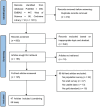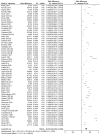Prevalence and correlations of schistosomiasis mansoni and schistosomiasis haematobium among humans and intermediate snail hosts: a systematic review and meta-analysis
- PMID: 39218903
- PMCID: PMC11367875
- DOI: 10.1186/s40249-024-01233-0
Prevalence and correlations of schistosomiasis mansoni and schistosomiasis haematobium among humans and intermediate snail hosts: a systematic review and meta-analysis
Abstract
Background: The control of schistosomiasis is particularly difficult in sub-Saharan Africa, which currently harbours 95% of this disease. The target population for preventive chemotherapy (PC) is expanded to all age group at risk of infection, thus increasing the demands of praziquantel (PZQ) tablets according to the new released guideline by World Health Organization. Due to the gap between available PZQ for PC and requirements, alternative approaches to assess endemicity of schistosomiasis in a community, are urgently needed for more quick and precise methods. We aimed to find out to which degree the infection status of snails can be used to guide chemotherapy against schistosomiasis.
Methods: We searched literature published from January 1991 to December 2022, that reported on the prevalence rates of Schistosoma mansoni, S. haematobium in the intermediate snails Biomphalaria spp. and Bulinus spp., respectively, and in humans. A random effect model for meta-analyses was used to calculate the pooled prevalence estimate (PPE), with heterogeneity assessed using I-squared statistic (I2), with correlation and regression analysis for the exploration of the relationship between human S. mansoni and S. haematobium infections and that in their specific intermediate hosts.
Results: Forty-seven publications comprising 59 field investigations were included. The pooled PPE of schistosomiasis, schistosomiasis mansoni and schistosomiasis haematobium in humans were 27.5% [95% confidence interval (CI): 24.0-31.1%], 25.6% (95% CI: 19.9-31.3%), and 28.8% (95% CI: 23.4-34.3%), respectively. The snails showed an overall infection rate of 8.6% (95% CI: 7.7-9.4%), with 12.1% (95% CI: 9.9-14.2%) in the Biomphalaria spp. snails and 6.9% (95% CI: 5.7-8.1%) in the Bulinus spp. snails. The correlation coefficient was 0.3 (95% CI: 0.01-0.5%, P < 0.05) indicating that the two variables, i.e. all intermediate host snails on the one hand and the human host on the other, were positively correlated.
Conclusions: The prevalence rate of S. mansoni and S. haematobium is still high in endemic areas. Given the significant, positive correlation between the prevalence of schistosomes in humans and the intermediate snail hosts, more attention should be paid to programme integration of snail surveillance in future.
Keywords: Biomphalaria; Bulinus; Schistosoma haematobium; Schistosoma mansoni; Africa; Correlation analysis; Meta-analysis; Prevalence.
© 2024. The Author(s).
Conflict of interest statement
All authors declare no competing interests.
Figures



References
Publication types
MeSH terms
Grants and funding
LinkOut - more resources
Full Text Sources
Research Materials
Miscellaneous

